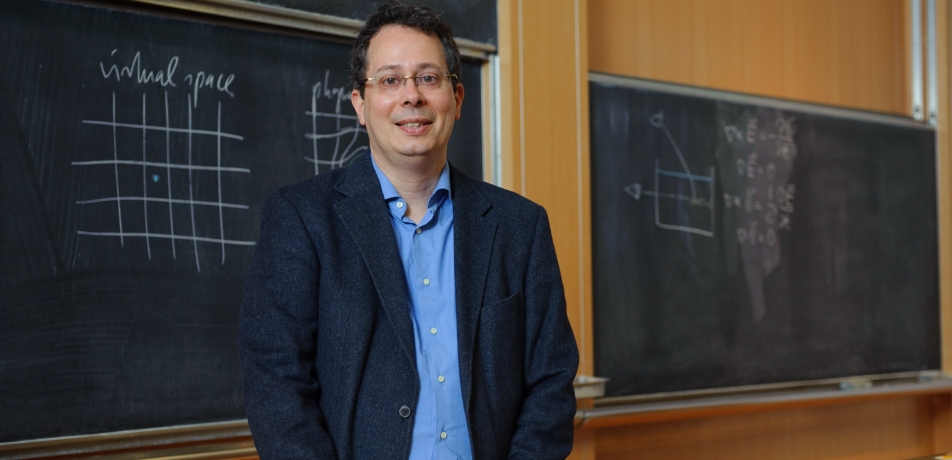The Science of Invisibility & Black Holes
Prof. Ulf Leonhardt
Briefs

The Science of Invisibility
From H.G. Wells’ The Invisible Man to cloaking devices for Klingon starships on Star Trek, science fiction is full of schemes to make people and objects disappear.
Prof. Ulf Leonhardt in the Department of Physics of Complex Systems is turning some of that fiction into science.
Prof. Leonhardt, co-founder of a new field called “transformational optics,” explains that the science of invisibility cloaking is based on a simple idea that is inspired by general relativity. The idea is that optical media—glass, water, or sophisticated meta-materials—change the way light perceives space, altering the geometry of space. Visualize this: an otherwise straight stick appears to bend at the surface when poked into water, and a fish in a pond is not where it appears to be from the surface.
As a graphic demonstration, Prof. Leonhardt drops a handful of what look like clear glass marbles into a beaker of water. They appear to “disappear” in the water, since the optical refraction index - a computation of the speed of light in a particular medium - of the water is the same as the balls. They become visible again when taken out. This experiment has the same theoretical basis that the Invisible Man uses in the classic science fiction story, where a “mad” scientist devises a way to make the cells of his body have the same refractive index as air.
With the tremendous advances in optics and electronics in the past few decades, the idea of invisibility cloaking devices is not so far-fetched, he says. For instance, the B-1 bomber is a stealth aircraft that is designed to be nearly invisible to radar waves. While its sleek black body is perfectly visible to the eye, radar signals are baffled by its angular shape and high-tech composite skin. A few years ago, Prof. Leonhardt and others demonstrated electromagnetic devices that could create a “cloak” to make a small object invisible to certain microwave frequencies. Other researchers have since created sound and even heat-cloaking devices on a small scale.
These experiments show both the potential for cloaking technology and one of its major challenges: achieving broadband invisibility. Scientists can create an airplane that is nearly invisible to radar, but not to light waves; and they can create a cloaking device for microwaves, but not for other wavelengths at the same time. To achieve this, one would have to bend space itself, not just light or electromagnetic microwaves.
Black Holes
The ultimate bending of space occurs in a black hole, where massive stars collapse into an object so massive that light and matter cannot escape from its gravitational pull. Astronomers can only locate black holes by observing the distortion, or lensing effect, caused by light waves from more distant stars bent by the gravitational pull.
However, in the 1970s, physicist Stephen Hawking theorized that even a black hole would emit a certain kind of radiation. Yet, astronomers have found so-called Hawking radiation too weak to measure because it is drowned out by the cosmic microwave background—the dim remnant radiation from the Big Bang that created the universe. Prof. Leonhardt is engaged in a set of experiments that involve creating an artificial “black hole” that might demonstrate Hawking radiation for the first time.
To understand the concept of a black hole, imagine a river that flows faster and faster until it tumbles over a waterfall (the black hole). Suppose that at some point upstream of the falls the speed of the river becomes faster than a fish can swim. This is the event horizon of the aquatic black hole, Prof. Leonhardt explains. Several years ago, he realized that he could create a simulation of the event horizon of a black hole using optical communications fibers and the ultrafast pulses of light made possible by advances in optics. The optical fiber, created with micro-patterns on the inside, acts as the flowing river. Light slows down a fraction upon entering the fiber, and a pair of carefully created ultrafast pulses of different colored laser light can, in effect, chase each other through the fiber tunnel, the first interfering with the second and creating a sort of event horizon. When the first intense pulse of light hits the fiber, it changes the physical properties of the fiber, creating a distortion that amounts to a change in the fiber’s index of refraction. This nonlinear effect moves along with the pulse, although nothing material is moving, and the first pulse is slowed by this distortion.
The researchers were able to detect a classical optical effect, the blue-shifting of light at the “white-hole” event horizon of their optical fiber experiment. To understand how this could be evidence for an event horizon similar to a black hole, imagine another situation: a river flowing out into the sea, getting slower and slower. Waves coming from the sea are stopped at the line where the downstream flow exceeds the incoming wave speed. This would be analogous to a white hole, an object that nothing can enter (as opposed to a black hole where nothing can escape).
A tabletop “black hole” made from a length of optical fiber and a laser may prove invaluable in understanding both the physics of light and the astrophysics of black holes.
Prof. Ulf Leonhardt is funded by Jinich Postdoctoral Fellowship.








